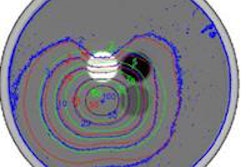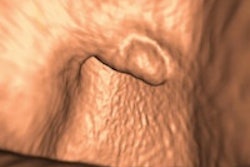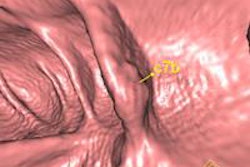More efficient detector circuitry can reduce image noise in CT colonography (CTC) images by about 10% -- or, alternatively, reduce radiation dose by about 20% if noise levels were to remain unchanged -- according to a study of nearly 400 individuals.
In the study, half of the patients were scanned using a conventional dual-energy CT (DECT) scanner, and the other half with a new type of integrated circuit (IC) detector technology. CT dose index (CTDIvol) levels were the same for both groups, but image noise was significantly lower in the IC detector cohort.
"Image noise was reduced by about 10% even though IC patients were a little larger," said Tom O'Donnell from Siemens Healthcare who presented the results at ECR 2014 on behalf of Cynthia McCollough, PhD, and colleagues at Mayo Clinic. "We estimated that we can save dose and that we're reducing noise," O'Donnell said.
In their study, McCollough and her team, including Shuai Leng, PhD; Greg Michalak, PhD; and Dr. Joel Fletcher, sought to investigate whether the use of an IC detector results in reduced noise in CTC.
With low-dose CT, "usually you're concerned about statistical noise -- or quantum noise -- this usually increases as dose decreases, so if you want to reduce [statistical] noise by half, you have to quadruple the dose," O'Donnell explained. "Up until now, we haven't had much chance to deal with the other source of noise, which is electronic noise. This is generally negligible at typical dose levels; however, if you're doing a low-dose scan, or scans of large patients, the signal is down, so [electronic noise] becomes an issue."
The idea is to minimize the distance the analog signal has to travel before it is converted to digital, he said. Siemens achieved this by coupling analog-to-digital signal converters (ADC) directly to the output of the detector.
In a cohort of 366 consecutive CTC screening subjects, the first 185 (April 2009 to March 2012) were scanned using a DECT scanner (Definition Flash, Siemens Healthcare) equipped with a standard detector. At that point, new Stellar integrated detectors were installed in the scanner, and the next 181 patients were scanned after the conversion to an integrated detector in March 2012, "basically keeping everything the same but swapping in new detectors," O'Donnell said.
Before and after the switch, CTC was performed at a reference kV value of 120 and a quality reference mAs value of 50, with a 0.5-sec rotation, 128 x 0.06 collimation, and pitch of 1.4. Images were reconstructed using 1-mm-thick slices and a 0.8-mm increment, and a B30 kernel. All images were acquired after routine bowel cleansing and automated colonic insufflation (ProtoCO2l, Bracco).
The researchers retrospectively evaluated the supine images only, looking for differences before and after the detector conversion. They examined two axial images per patient exam: in the abdomen between the hepatic and splenic flexures, and in the pelvis within the bony pelvis, O'Donnell said.
Signal represented the mean CT value in the liver and iliopsoas muscle, while noise (standard deviation of CT values) was measured in the anterior and posterior subcutaneous fat regions. Patient body size can be automatically measured from axial CT images by calculating a water-equivalent diameter (Dw), so this was calculated for each image.
Reduced noise with new detector
For the abdomen and the pelvis, despite significantly larger patient sizes in the IC detector cohort (both p < 0.001), image noise was significantly lower (both p < 0.001), whereas CTDIvol was unchanged (both p > 0.05). For the same noise level, conversion to the new detectors led to an estimated dose reduction of 23% in the abdomen and 20% in the pelvis, O'Donnell said.
| Patients scanned with integrated detector scanner were significantly larger | |||
| Detector type | Patients (n) | Dw abdomen | Dw pelvis |
| Conventional | 185 | 30.5 ± 2.6 cm | 30.8 ± 2.3 cm |
| Integrated | 181 | 33.1 ± 2.9 cm (p < 0.001) | 33.9 ± 2.8 cm (p < 0.001) |
| Integrated detector reveals lower noise, higher signal-to-noise ratios (SNR) compared with conventional detector | ||||
| Detector type | Noise abdomen | Noise pelvis | SNR liver | SNR iliopsoas |
| Conventional | 36.6 ± 6.9 HU | 37.7 ± 7.5 HU | 1.06 ± 0.40 | 1.14 ± 0.47 |
| Integrated | 33.0 ± 5.2 HU (p < 0.001) |
34.4 ± 6.4 HU (p < 0.001) |
1.31 ± 0.47 (p < 0.001) |
1.27 ± 0.46 (p = 0.01) |
"Image noise was reduced by about 10% even though the patients were a little larger," O'Donnell said. Alternatively, had the same noise levels been kept using the integrated circuit detectors, the dose could have been reduced by an estimated 20%, he said.



















